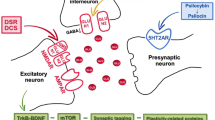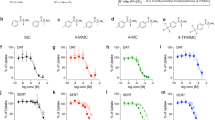Abstract
myo-Inositol (mI) is a key metabolic precursor to the phospoinositide (PI) metabolic pathway as a key component of central G-protein coupled receptor signaling systems, including several subtypes of adrenergic, cholinergic, serotonergic and metabotropic glutamatergic receptors. High dose mI has also been shown to be clinically effective in the treatment of obsessive-compulsive disorder, as well as panic and depression, although its mechanism of action remains elusive. The current study aimed to investigate the possible modulatory role of mI versus fluoxetine or imipramine pretreatments on serotonin-2A receptor (5HT2A-R) and muscarinic acetylcholine receptor (mAChR) function and binding in in vitro systems. After pretreating human neuroblastoma cells with different concentrations of mI, fluoxetine, or imipramine, receptor function was measured by second messenger [3H]-IP x accumulation and [35S]-GTPγS binding to Gαq protein. Total [3H]-mI uptake into cells was measured, as well as specific receptor binding to determine receptor binding after the pretreatments. Results suggest that mI reduces 5HT2A-R function at the receptor-G protein level. While fluoxetine also reduced 5HT2A-R function, but to a lesser degree, imipramine increased 5HT2A-R function, which may explain why mI seems to be effective exclusively in selective serotonin reuptake inhibitor-sensitive disorders. In addition mI, and at high concentrations fluoxetine and imipramine, also reduces mAChR function. Furthermore the results suggest that the attenuating effect of mI on mAChRs is partially dependent on the PI metabolic pathway. The data provide novel information on understanding the mechanism of action of mI in depression and related anxiety disorders and added to the evidence suggesting a role for the cholinergic system in the pathophysiology of depression.
Similar content being viewed by others
references
Ackerman, D.L., and Greenland, S. (2002). Multivariate meta-analysis of controlled drug studies for obsessive-compulsive disorder. J. Clin. Psychopharmacol. 22:309-317.
Anderson, I.M. (2000). Selective serotonin reuptake inhibitors versus tricyclic antidepressants: A meta-analysis of efficacy and tolerability. J. Affect. Disord. 58:19-36.
Baldessarini, R.J. (2001). Drugs and the treatment of psychiatric disorders. In (J.G. Hardman, and L.E. Limbird, eds.), Goodman & Gilman's the Pharmacological Basis of Therapeutics, 10th edn. no., McGraw-Hill, New York, pp. 447-483.
Balla, T., Bondeva, T., and Varnai, P. (2000). How accurately can we image inositol lipids in living cells? Trends Pharmacol. Sci. 21:238-241.
Batty, I.H., and Downes, C.P. (1995). The mechanism of muscarinic receptorstimulated phophatidylinositol re-synthesis in 1321N1 astrocytoma cells and its inhibition by Li+ ions. J. Neurochem. 65:2279-2289.
Berry, G.T., Mallee, J.J., Kwon, H.M., Rim, J.S., Mulla, W.R., Muenke, M., and Spinner, N.B. (1995). The human osmoregulatory Na+/myoinositol cotransporter gene (SLC5A3): Molecular cloning and localization to chromosome 21. Genomics 25:507-513.
Blier, P. (2003). The pharmacology of putative early-onset antidepressant strategies. Eur. Neuropsychopharmacol. 13:57-66.
Boess, F.G., and Martin, I.L. (1994). Molecular biology of 5-HT receptors. Neuropharmacology 33:275-317.
Casarosa, P., Bakker, R.A., Verzijl, D., Navis, M., Timmerman, H., Leurs, R., and Smit, M. (2001). Constitutive signalling of the human cytomegalovirus-encoded chemokine receptor US28. J. Biol. Chem. 276:1133-1137.
Chau, D.T., Rada, P., Kosloff, R.A. Taylor, J.L., and Hoebel, B.G. (2001). Nucleus accumbens muscarinic receptors in the control of behavioral depression: Antidepressant-like effects of local M1 antagonist in the Porsolt swim test. Neuroscience 104:791-798.
Clements, R.S., Jr., and Diethelm, A.G. (1979). The metabolism of myoinositol by the human kidney. J. Lab. Clin. Med. 93:210-219.
Daws, L.C., and Overstreet, D.H. (1999). Ontogeny of muscarinic cholinergic supersensitivity in the Flinders Sensitive Line rat. Pharmacol. Biochem. Behav. 62:367-380.
DeLapp, N.W., McKenzie, J.H., Sawyer, B.D., Vandergriff, A., Falcone, J., McClure, D., and Felder, C.C. (1999). Determination of [35S]Guanosine-5'-O-(3-thio)triphosphate binding mediated by cholinergic muscarinic receptors in membranes from Chinese hamster ovary cells and rat striatum using an anti-G protein scintillation proximity assay. J. Pharmacol. Exp. Ther. 289:946-955.
Einat, H., and Belmaker, R.H. (2001). The effects of inositol treatment in animal models of psychiatric disorders. J. Affect. Disord. 62:113-121.
Einat, H., Clenet, F., Shaldubina, A., Belmaker, R.H., and Bourin, M. (2001). The antidepressant activity of inositol in the forced swim test involves 5HT2 receptors. Behav. Brain Res. 118:77-83.
Einat, H., Elkabaz-Shwortz, Z., Cohen, H., Kofman, O., and Belmaker, R.H. (1998). Chronic epi-inositol has an anxiolytic-like effect in the plusmaze model in rats. Int. J. Neuropsychopharmacol. 1:31-34.
Faravelli, C., Cosci, F., Ciampelli, M., Scarpato, M.A., Spiti, R., and Ricca, V. (2003). A self-controlled, naturalistic study of selective serotonin reuptake inhibitors versus tricyclic antidepressants. Psychother. Psychosom. 72:95-101.
Ferguson, S.S., Zhang, J., Barak, L.S., and Caron, M.G. (1998). Molecular mechanisms of G protein-coupled receptor desensitization and resensitization. Life Sci. 62:1561-1565.
Fisher, S.K., Novak, J.E., and Agranoff, B.W. (2002). Inositol and higher inositol phosphates in neural tissues: Homeostasis, metabolism and functional significance. J. Neurochem. 82:1-19.
Freedman, N.J., and Lefkowitz, R.J. (1996). Desensitization of G proteincoupled receptors. Recent Prog. Horm. Res. 51:319-351.
Gaidarov, I., Krupnick, J.G., Flack, J.R., Benovic, J.L., and Keen, J.H. (1999). Arrestin function in G-protein-coupled receptro endocytosis requires phosphoinositide binding. EMBO J. 18:871-881.
Gray, J.A., and Roth, B.L. (2001). Paradoxical trafficking and regulation of 5-HT2A receptors by agonists and antagonists. Brain Res. Bul. 56:441-451.
Harvey, B.H. (1997). The neurobiology and pharmacology of depression. A comparative overview of serotonin selective antidepressants. S. Afr. Med. J. 87:540-552.
Harvey, B.H., Brink, C.B., Seedat, S., and Stein, D.J. (2002). Defining the neuromolecular action of myo-inositol application to obsessive-compulsive disorder. Prog. Neuropsychopharmacol. Biol. Psychiatry 26:21-32.
Harvey, B.H., Naciti, C., Brand, L., and Stein, D.J. (2003). Endocrine, cognitive and hippocampal/cortical 5HT1A/2A receptor changes evoked by a time dependent sensitisation (TDS) stress model in rats. Brain Res. 983:97-107.
Harvey, B.H., Scheepers, A.S., Brand, L., and Stein, D.J. (2001). Chronic inositol increases striatal D2 receptors but does not modify dex-amphetamine-induced motor behavior. Pharmacol. Biochem. Behav. 68:245-253.
Hauser, G., and Finelli, V.N. (1963). The biosynthesis of free and phosphatide myoinositol from glucose in mammalian tissues. J. Biol. Chem. 238:3224-3228.
Häussinger, D., Laubenberger, J., Vom Dahl, S., Ernst, T., Bayer, S., Langer, M., Gerok, W., and Henning, J. (1994). Proton magnetic resonance spectroscopy studies on human brain myo-inositol in hypo-osmolarity and hepatic encephalopathy. Gastroenterology 107:1475-1480.
Holub, B.J. (1986). Metabolism and function of myo-inositol and inositol phospholipids. Annu. Rev. Nutr. 6:563-597.
Jackson, P.S., and Madsen, J.R. (1997). Identification of the volumesensitive organic osmolyte/anion channel in human glial cells. Pediatr. Neurosurg. 27:286-291.
Jackson, P.S., and Strange, K. (1993). Volume-sensitive anion channels mediate swelling-activated inositol and taurine efflux. Am. J. Physiol. 265:C1489-C1500.
Kaplan, Z., Amir, M., Swartz, M., and Levine, J. (1996). Inositol treatment of post-traumatic stress disorder. Anxiety 2:51-52.
Kukkonen, J., Ojala, P., Näsman, J., Hämäläinen, H., Heikkilä, J., and åkerman, K.E. (1992). Muscarinic receptor subtypes in human neuroblastoma cell lines SH-SY5Y and IMR-32 as determined by receptor binding, Ca2+ mobilization and northern blotting. J. Pharmacol. Exp. Ther. 263:1487-1493.
Levine, J. (1997). Controlled trials of inositol in psychiatry. Eur. Neuropsychopharmacol 7:147-155.
Low, M.G. (2000). Glycosylphosphatidylinositol-anchored proteins and their phospholipases. In (S. Cockcroft, ed.), Biology of Phosphoinositides, Oxford University Press, Oxford, pp. 210-239.
McDonough, M., and Kennedy, M. (2002). Pharmacological management of obsessive-compulsive disorder: A review for clinicians. Harv. Rev. Psychiatry 10:127-137.
McKittrick, C.R., Blanchard, C.D., Blanchard, R.J., McEwen, B.S., and Sakei, R.R. (1995). Serotonin receptor binding in a colony model of chronic social stress. Biol. Psychiatry 37:383-393.
Meyerson, L.R., Wennogle, L.P., Abel, M.S., Coupet, J., Lippa, A.S., Rauh, C.E., and Beer, B. (1982). Human brain receptor alterations in suicide victims. Pharmacol. Biochem. Behav. 17:159-163.
Nemeroff, C.B. (2002). Recent advances in the neurobiology of depression. Psychopharmacol. Bull. 36(Suppl. 2):6-23.
Nemets, B., Talesnick, B., Belmaker, R.H., and Levine, J. (2002). Myo-inositol has no beneficial effect on premenstrual dysphoric disorder. World J. Biol. Psychiatry 3:147-149.
Oquendo, M.A., Placidi, G.P., Malone, K.M., Campbell, C., Keilp, J., Brodsky, B., Kegeles, L.S. Cooper, T.B., Parsey, R.V., van Heertum, R.L., and Mann, J.J. (2003). Positron emission tomography of regional brain metabolic responses to a serotonergic challenge and lethality of suicide attempts in major depression. Arch. Gen. Psychiatry 60:14-22.
Payrastre, B., Missy, K., Giuriato, S., Bodin, S., Plantavid, M., and Gratacap, M. (2001). Phosphoinositides: Key players in cell signalling, in time and space. Cell. Signa. 13:377-387.
Pigott, T.A. (1996). OCD: Where the serotonin selective story begins. J. Clin. Psychiatry 57:11-20.
Rahman, S., and Neuman, R.S. (1993). Myo-inositol reduces serotonin (5-HT2) receptor induced homologous and heterologous desensitization. Brain Res. 631:349-351.
Richelson, E. (1994). The pharmacology of antidepressants at the synapse: Focus on newer compounds. J. Clin. Psychiatry 55:A34-A39.
Roth, B.L., McLean, S., Zhu, X.Z., and Chuang, D.M. (1987). Characterization of two [3H]ketanserin recognition sites in rat striatium. J. Neurochem. 49:1833-1838.
Rubin, R.T., Abbasi, S.A., Rhodes, M.E., and Czambel, R.K. (2003). Growth hormone responses to low-dose physostigmine administration: Functional sex differences (sexual diergism) between major depressives and matched controls. Psychol. Med. 33:655-665.
Rubin, R.T., O'Toole, S.M., Rhodes, M.E., Sekula, L.K., and Czambel, R.K. (1999). Hypothalamo-pituitary-adrenal cortical responses to low-dose physostigmine and arginine vasopressin administration: Sex differences between major depressives and matched control subjects. Psychiatry. Res. 89:1-20.
Seedat, S., Stein, D.J., and Harvey, B.H. (2001). Inositol in the treatment of compulsive skin picking and trichotillomania. J. Clin. Psychiatry 62, 60-61.
Shytle, R.D., Silver, A.A., Lucas, R.L., Newman, M.B., Sheehan, D.V., and Sanberg, P.R. (2002). Nicotinic acetylcholine receptors as targets for antidepressants. Mol. Psychiatry 7:525-535.
Slowiejko, D.M., McEwen, E.L., Ernst, S.A., and Fisher, S.K. (1996). Muscarinic receptor sequestration in SH-SY5Y neuroblastoma cells is inhibited when clathrin distribution is perturbed. J. Neurochem. 66:186-196.
Sorensen, S.D., Linseman, D.A., Mcewen, E.L., Heacock, A.M., and Fisher, S.K. (1998). A role for a Wortmannin-sensitive phosphatidylinositol-4-kinase in the endocytosis of muscarinic cholinergic receptors. Mol. Pharmacol. 53:827-836.
Stein, D.J., Spadaccini, E., and Hollander, E. (1995). Meta-analysis of pharmacotherapy trials for obsessive-compulsive disorder. Int. Clin. Psychopharmacol. 10:11-18.
Toker, A., and Cantley, L.C. (1997). Signalling through the lipid products of phosphoinositide-3-OH kinase. Nature 387:673-676.
Trivedi, M.H. (2003). Treatment-resistant depression: New therapies on the horizon. Ann. Clin. Psychiatry 15:59-70.
Tummel, K.E., and Shen, D.D. (2001). Appendix II: Design and optimization of dosage regimens: Pharmacokinetic data. In (J.G. Hardman and L.E. Limbird, eds.), Goodman & Gilman's the Pharmacological Basis of Therapeutics, 10th edn., McGraw-Hill, New York, pp. 1917-2023.
Uldry, M., Ibberson, M., Horisberger, J.D., Chatton, J.Y., Riederer, B.M., and Thorens, B. (2001). Identification of a mammalian H (+)-myoinositol symporter expressed predominantly in the brain. EMBO J. 20:4467-4477.
Vanhaesebroeck, B., Leevers, S.J., Ahmadi, K., Timms, J., Katso, R., Driscoll, P.C., Woscholski, R., Parker, P.J., and Waterfield, M.D. (2001). Synthesis and function of 3-phosphorylated inositol lipids. Annu. Rev. Biochem. 70:535-602.
Author information
Authors and Affiliations
Rights and permissions
About this article
Cite this article
Brink, C.B., Viljoen, S.L., de Kock, S.E. et al. Effects of myo-Inositol Versus Fluoxetine and Imipramine Pretreatments on Serotonin 5HT2A and Muscarinic Acetylcholine Receptors in Human Neuroblastoma Cells. Metab Brain Dis 19, 51–70 (2004). https://doi.org/10.1023/B:MEBR.0000027417.74156.5f
Issue Date:
DOI: https://doi.org/10.1023/B:MEBR.0000027417.74156.5f




